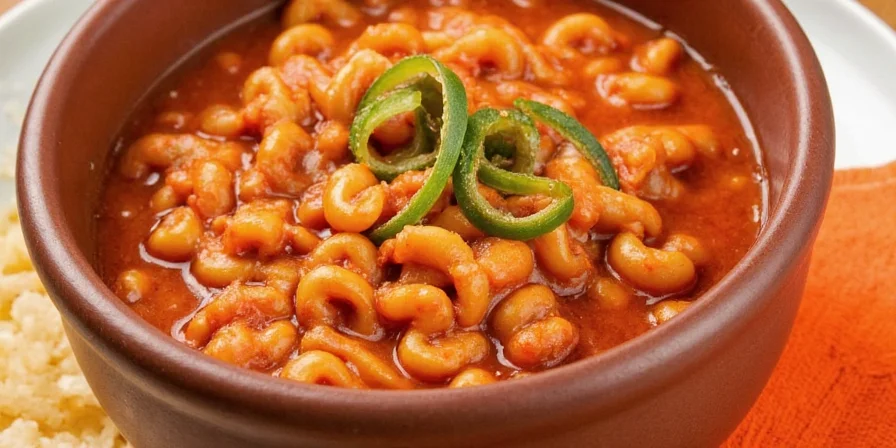Looking for the perfect spicy macaroni chili soup recipe? Here's a complete, easy-to-follow recipe with professional chef techniques that delivers balanced heat and rich flavor in just 45 minutes. This authentic recipe makes 6 servings and includes all essential ingredients and step-by-step instructions.
Authentic Spicy Macaroni Chili Soup Recipe

Ingredients
- 1 tbsp olive oil
- 1 large yellow onion, diced
- 3 cloves roasted garlic, minced
- 1 lb ground beef or plant-based alternative
- 2 (15oz) cans kidney beans, drained
- 1 (28oz) can crushed tomatoes
- 4 cups beef or vegetable broth
- 1 cup elbow macaroni
- 2 tbsp chili powder
- 1 tsp cumin seeds, toasted
- 1 dried ancho pepper
- 1 serrano pepper, minced
- 1 tsp smoked paprika
- 1 tsp soy sauce (for umami)
- Salt and black pepper to taste
Step-by-Step Instructions
- Toast spices: In dry pan over medium heat, toast cumin seeds until fragrant (1-2 minutes). Grind and set aside.
- Sauté aromatics: Heat olive oil, cook onions until caramelized (8-10 minutes), add roasted garlic.
- Brown meat: Add ground beef, cook until no pink remains, breaking into small pieces.
- Bloom spices: Stir in chili powder, smoked paprika, and ground cumin; cook 30 seconds in oil.
- Build base: Add crushed tomatoes, broth, whole ancho pepper, 3/4 of beans. Simmer 20 minutes.
- Cook pasta: Add macaroni and simmer until al dente (8-10 minutes).
- Thicken broth: Mash remaining beans and stir into soup.
- Finish: Remove ancho pepper, stir in soy sauce and fresh serrano. Adjust seasoning.
Why This Recipe Works: Science-Backed Spice Techniques

This recipe incorporates professional techniques that address common home cooking mistakes. The key is understanding how spices interact with other ingredients at molecular level - dry-toasting whole spices before grinding releases complex flavor compounds that powder spices can't match.
Pepper Power: Heat Levels Decoded

| Pepper Type | Heat Level (Scoville Units) | Flavor Profile | Best For |
|---|---|---|---|
| Jalapeño | 2,500 – 8,000 | Grassy, slightly fruity | Mild spice lovers, garnishes |
| Serrano | 10,000 – 23,000 | Sharp, bright | Cooked dishes, salsas |
| Hatch Green Chile | 2,500 – 5,000 | Earthy, smoky | Stews, soups, roasted |
| Ancho (Dried Poblano) | 1,000 – 2,000 | Smoky, sweet, raisin-like | Dried applications, sauces |
| Ghost Pepper | 1,000,000+ | Burning intensity with fleeting sweetness | Challenges, daredevils only |
Debunking Common Spice Myths

- Myth #1: Spicy food damages your stomach. Fact: Capsaicin may actually strengthen stomach lining; ulcers primarily stem from H. pylori bacteria.
- Myth #2: Heat tolerance is genetic. Fact: Regular exposure builds temporary tolerance through nerve desensitization.
- Myth #3: Milk neutralizes spice best. Fact: Full-fat dairy works better than skim due to casein binding with capsaicin.
- Myth #4: Spicy food speeds metabolism significantly. Fact: Temporary 5-10% increase is negligible for weight loss.
- Myth #5: All red peppers are interchangeable. Fact: Paprika (sweet), cayenne (hot), and chipotle (smoky) create distinctly different flavor profiles.
Perfect Pairings for Your Spicy Soup

Complementary pairings should cool the palate while enhancing the soup's complexity. Avoid overly sweet sides that clash with savory notes:
- Avocado slices: Creamy texture counteracts heat while adding healthy fats
- Lime-dressed slaw: Crunchy contrast with acid that lifts rich flavors
- Charred cornbread: Light sweetness balances heat without overwhelming
- Cucumber raita: Yogurt-based dip cools while adding probiotic benefits
- Mexican lager: Carbonation and citrus notes cleanse the palate between bites
Final Thoughts

Mastering macaroni chili soup requires understanding spice chemistry, not just adding heat. The key is building flavor layers where each ingredient contributes to harmony rather than competition. Remember that optimal spice level varies by individual—aim for warmth that invites second helpings, not pain that ends the meal.
Modern adaptations honor the dish's Depression-era roots while embracing global techniques. By applying these principles, you'll create soup that satisfies both traditionalists and adventurous eaters. Now grab your pot and transform simple ingredients into a memorable culinary experience.
Frequently Asked Questions
How can I reduce soup spiciness after it's cooked?
Add dairy (sour cream or full-fat yogurt), acidic elements (lime juice), or starchy components (mashed beans). Dilute with additional broth if needed, but avoid adding sugar as it creates unwanted flavor conflicts.
Why does my soup taste flat despite adding multiple spices?
Spices need proper activation—toast whole spices before grinding, bloom dried spices in oil, and add acidic components late in cooking. Undersalting is the most common culprit; adjust salt gradually at serving temperature.
Can I use gluten-free pasta without compromising texture?
Yes, but cook separately to al dente and add during the last 10 minutes of simmering. Brown rice pasta holds shape best, while chickpea pasta offers protein boost. Always rinse under cold water after cooking to prevent gummy texture.
How do I store leftovers properly?
Cool within 2 hours, then refrigerate in airtight containers for up to 4 days. Freeze portions for 3 months. Reheat gently with a splash of broth to revive consistency—microwaving causes uneven texture.
What's the secret to restaurant-quality depth?
Build flavor foundations: sauté aromatics until caramelized, use roasted garlic instead of raw, incorporate umami boosters like tomato paste or soy sauce, and finish with fresh herbs. Simmering time matters—minimum 30 minutes for flavors to meld.











 浙公网安备
33010002000092号
浙公网安备
33010002000092号 浙B2-20120091-4
浙B2-20120091-4